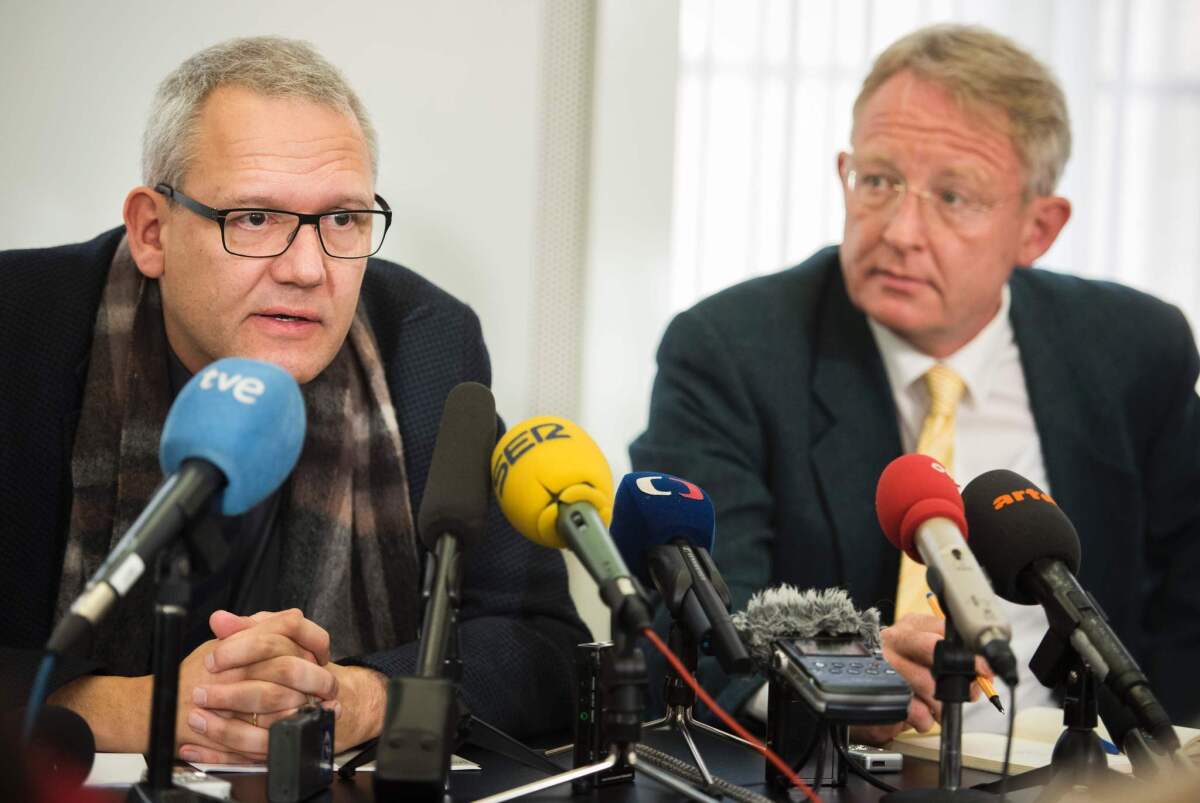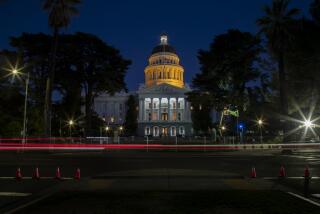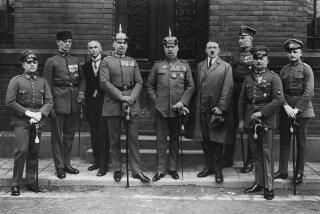German republication of Hitler’s ‘Mein Kampf’ causes furor

Scholars Andreas Wirsching, left, and Christian Hartmann speak to the media in Berlin about the re-release of Adolf Hitler’s “Mein Kampf.”
- Share via
Reporting from Berlin — A controversial book by one of Germany’s bestselling authors will be republished next week: Adolf Hitler’s “Mein Kampf.”
The new two-volume edition of “Mein Kampf,” filled with 3,700 critical annotations by historians that are designed to demystify Hitler’s propaganda, will be back in bookstores Jan. 8 -- just one week after the 70-year copyright on the original text expired Dec. 31.
It will end a postwar ban in Germany on the anti-Semitic, race-based manifesto that sold 12.4 million copies in the nation from 1925 to 1945 and was translated into 18 foreign languages.
Join the conversation on Facebook >>
Despite being banned in Germany, the book has continued to sell in some countries, including the United States. Many Germans inherited dusty copies of the original in their homes. There are no rules against owning an original copy even though Germany has tight restrictions on free speech when it comes to the Nazi era and anyone convicted of denying the Holocaust can end up in jail.
The German republication of the book -- which was first published shortly before Hitler stormed into power after an election in 1933 -- has, however, caused unease in the country that started World War II and has suffered shame for the systematic murder of 6 million Jews.
Some believe critical notations alongside the original text will serve as a useful educational tool that should be part of the curriculum in German high schools because it exposes the evils of Hitler. But others fear his diatribes against Jews, Socialists, Marxists and parliamentary democracy could be taken at face value and will only encourage far-right extremists. In any case, the end of the ban on “Mein Kampf” reflects Germany’s yearning for “normalization” in contemplating its Nazi past some seven decades after the end of World War II.
“The German identity will continue to be weighed down by the historical experience of the Nazi past, but it’s a sign of a normalization if a large majority of Germans are now able to deal with a new edition of ‘Mein Kampf,’” said Sabine von Oppeln, a political scientist at Berlin’s Free University, whose parents were handed a copy of the original by the state as a wedding present along with their marriage certificate in 1939.
Hitler started working on the largely autobiographical book from jail in the southern Bavarian town of Landsberg in 1924, where he was sentenced for his failed putsch in Munich a year earlier. He wrote most of the first volume from that prison and the second volume after his release. At first a flop, the book in which he outlined his political ideology and strategy surged in sales in the 1930s. In 1925 he bought a Mercedes for 20,000 reichsmarks with his earnings. Royalties rose to 62,340 reichsmarks in 1932, and then in 1933, after he took power, they soared to 1,232,335 reichsmarks for the million copies sold that year.
“The book turned Hitler into a multimillionaire,” said Christian Hartmann, one of six historians at the Institute for Contemporary History (IfZ) in Munich who have worked on the annotated edition since 2012.
But Hitler’s handsome earnings also drew the attention of tax authorities in Munich, who pestered him about his income for several years. He tried to claim expenses of 616,167 reichsmarks to offset those earnings, but the tax office rejected about half of those. By 1935, Hitler owed 405,494 reichsmarks in back taxes but didn’t have to pay after finance ministries in Berlin and Munich pardoned him of all his tax obligations – one of the perks of becoming dictator.
In an exhaustive analysis, the newspaper Die Welt estimated that Hitler earned a total of 12 million reichsmarks, or 12,000 times more than the average annual income in Germany during the 1930s. With the copyright nearing expiration at the end of 2015, the state of Bavaria at first agreed to support a project by the Institute for Contemporary History to republish the book with the annotations from the six scholars. Their work more than doubled the size of the original to about 1,950 pages, published in two thick volumes. But Bavaria pulled out of the project, citing concerns it would offend families of Holocaust victims and survivors.
The question of whether the book should be allowed into German schools has sparked emotional debate. Although the federal government in Berlin has supported a call by the national teachers union GTA to include the new critical edition in high school class lessons on history and politics, the state government in Bavaria is skeptical and not planning to include it in school lessons anytime soon.
“This book still causes deep pain for a lot of people and we’re not going to have a simple reprint of it going into our schools,” said Ludwig Spaenle, the education minister in Bavaria, in an interview with the Munich newspaper Muenchner Merkur this week. “We’ll take legal action if necessary against that.”
The leader of Germany’s Jewish community in Munich, Charlotte Knobloch, has spoken out strongly against incorporating the annotated edition in classrooms. “It’s irresponsible to include such libelous invective against Jews in schools,” she told the Handelsblatt newspaper, adding that the book isn’t needed to teach young Germans what they need to know about Hitler.
Josef Kraus, head of the GTA, said he believed the critical edition would be an extremely useful tool to help young Germans better understand Hitler and the Nazi era. While earlier postwar generations studied the Nazi era intensively and critically, younger generations have increasingly tuned out after being bombarded from an early age.
“An edition of the book with critical commentary could help inoculate younger generations against political extremism,” Kraus said. The new edition combines Hitler’s text with a running commentary that points out not only his distortions of the truth, but also the half-truths, the omissions and his lies.
“We don’t let any of Hitler’s claims pass without our interpretation in our footnotes,” said Hartmann of the Institute for Contemporary History. Hartmann said that institute is not looking to earn money off the critical edition that it is publishing itself, instead looking only to recover its costs. Its initial printing run will be 4,000 copies and the book will cost $64.
Kirschbaum is a special correspondent.
More to Read
Sign up for Essential California
The most important California stories and recommendations in your inbox every morning.
You may occasionally receive promotional content from the Los Angeles Times.










